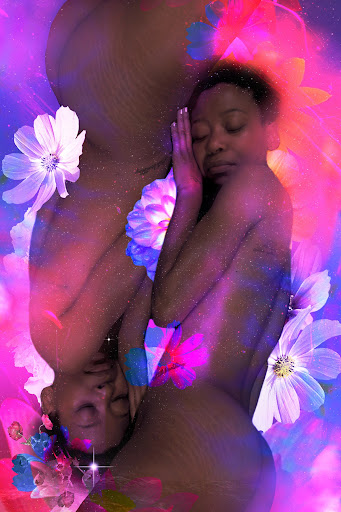What’s your flavour? Whether your tastes run to virtual sex, sixty-nining, or bondage, you don’t have to be cishet or gender nonconforming to enjoy a touch of novelty. (Photos & illustrations: Siphumeze Khundayi and Katia Herrera)
Sexuality and sex-positivity have become buzzwords of sorts on the internet, but they are often placed on a pedestal without a nuanced discussion of the complications that exist when sex is involved. Sex between queer people exists as a curiosity and is used by a heteronormative society to further the act of othering same-sex desire.
In Touch: Sex, Sexuality and Sensuality (Kwela Books), compiled by Tiffany Kagure Mugo and Kim Windvogel, the contributors unflinchingly confront the messiness of sex and subvert the narrative that sex-positivity is simply an act of being carefree. Just as human beings are layered, so are their sexual experiences, particularly those that are instrumental in a person’s sexual development.
Uncovering the myriad ways in which sex can occur between various genders, the anthology includes trauma, disappointment and abuse in an honest manner. The scourge of sexual violence is inescapable and features in some essays, considering most of the contributors live in South Africa. The anthology demystifies the narrative that same-sex sexual encounters guarantee iridescent orgasms
The collection also hacks away the narrow way in which sex is approached. The editors state, “Pleasure is rarely if ever, a topic of conversation. Touch is a cornucopia of ideas, notions and feelings. We wanted the contributors to write and create work that ensues and expresses the topic of sex in all of its complexities.”
 Some stories in ‘Touch’ feel like a release, a secret long kept with no language to name it.
Some stories in ‘Touch’ feel like a release, a secret long kept with no language to name it.
Writer and musician Nakhane writes of the tension between sexuality and religion while existing as a Black, queer, nonbinary person who is positioned in a Christian community. The tautness of falling into desire while holding onto subtle, but still quite violent, religious utterances point to Blackness as the root of everything Black. In their interactions with white Christian men, it is harrowing to watch their queerness and Blackness compounded to frame them as a sinner and temptress.
From a young age, “The Character” has a heightened awareness of the punitive repercussions that would befall them if they were ever discovered to have this desire. Writing about teenage fumblings in their childhood home, they say, “Although they continued this exploration, it was always with some sense of shame. If it wasn’t God, it was people. If not hell, then scorn or the belt. Punishment was due.”
Nakhane speaks loudly about a phenomenon that exists as a whisper in the all-boys school. The practice of homoerotic sexual experimentation is limited to certain acts, at the risk of trespassing certain boundaries that would tip them into homosexuality.
Even in scenes in which boys perform sexual acts, whether as a hazing ritual or an act of bonding, toxic masculinity exists at the periphery of the circle to remind young men that sexual experimentation must have its limit and can only exist in a way that is justifiable. This practice is damaging and acts as a proponent of shame, lest one is identified as gay and ostracised from a community.
 The subject matter under the banner of sex and sexuality is vast and trespasses geographic territory, as well as blurring the line between the personal and the political.
The subject matter under the banner of sex and sexuality is vast and trespasses geographic territory, as well as blurring the line between the personal and the political.
The anthology is cathartic and complicated. Themes of mental illness and grief ravage the book, through essays written by Mamello Sejake and Mia Arderne, acting as a reminder that queer sex is not utopian but burdened by the external influence of a heteropatriarchal society. Some stories feel like a release, a secret long kept with no language to name it, such as Sejake’s account of waking up to emptiness and various ceilings when the grief returns, and Arderne’s reckoning with love as being unable to act as a cure for mental illness.
These essays are visceral, with the truth surreptitiously slipping in between the sentences and illustrating that some sexual encounters can never act as a salve to grief. The beauty in Sejake’s story is finding sexual encounters that are grounded in care and consideration, reminding the reader that casual sex is not tantamount to careless sex.
The subject matter under the banner of sex and sexuality is vast and trespasses geographic territory, as well as blurring the line between the personal and the political. Allegory and theory flow throughout the anthology, with some writers taking a critical approach to explain how systems of domination are inextricable to sexual experiences. Performance of heteronormativity and toxic masculinity is identified as a deterrent to positive sexual experiences. Religious entanglement further complicates sexual expression and is identified as a proponent of shame.
Jamil Khan questions the societal expectation that a femme person cannot be assertive during sex or even ask for sex. The insertion of gender roles is prevalent in the LGBTIQ+ community, where femme-masc binaries reinforce patriarchal ideas of gender roles.
Zanta Nkumane questions the role of penetration and how the act is revered as the apex of sex. This is, of course, linked to phallic domination and phallocentric notions of masculinity. Nkumane says, “I would like to think sex is a language of desire — the erotic in action. Penetration settles in as the colloquial, the standard of pleasure. Yet I believe pleasure is multilingual and exists in many forms that don’t ultimately lead to penetration.”
 Touch, not merely a book about how sex manifests for queer people, is a contribution that presents an opportunity for learning.
Touch, not merely a book about how sex manifests for queer people, is a contribution that presents an opportunity for learning.
Lwando Scott, in his essay, also identifies how the language of “tops” and “bottoms” has created hierarchy and a crisis of power that is formulated around the dichotomy of dominance and submission. Scott also considers queer sex as a whole as a place for unlearning. In a society where heterosexuality is common and erroneously framed as a norm, queer people are socialised to perform gender, sexuality and sex in a predetermined manner.
From the accounts of Khan, Scott and Nkumane, there is an indication of the complexities of queer sex, particularly between partners who have to reckon with internalised homophobia, societal expectation and heteronormative performance.
Feminist writer and scholar Efemia Chela provides an honest account of dating as a bisexual woman and her decision to become celibate. While ruminating on her position as a feminist who dated men, she says, “It made me so aware of how the presence of entitled forms of masculinity destroy opportunities or relating to other people.” Her essay, while personal, also offers an opportunity for learning that bisexual dating and experiences are not a script that follows a 50:50 ratio of attraction to men and women.
Although the book is full to the point of rupture, the reader yearns for the essays to have been longer and for a deeper excavation in pieces that were more theoretical in nature. Perhaps the vastness of the topics clips the essays short in places that require more. Nonetheless, the anthology provides a nuanced perspective to queer sex, which is a personal act that is perpetually the topic for public discussion. The editors visibly carried the contributions gently and with the knowledge of the danger of reducing queer identity to sex.
While we occupy a place in society where there is no place to negotiate with bigotry and tradition, there is a vulnerability that permeates the book, which forces us to consider that safe spaces in a conservative society are a fallacy — but that one must speak regardless. Touch is not merely a book about how sex manifests for queer people but is a contribution that presents an opportunity for learning.